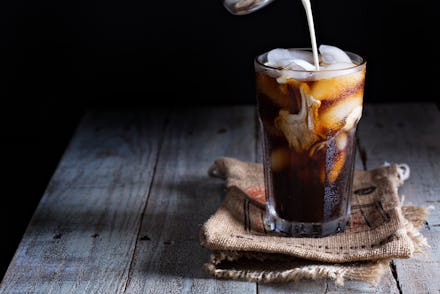What's the Difference Between Iced Coffee and Cold Brew?

Cold brew coffee is the new black.
Sales in the U.S. grew 115% from 2014 to 2015, according to a report from Mintel, a market intelligence agency. Once only found in hipster coffee shops off the beaten path, nowadays cold brew is available from big retail chains like Starbucks. Cue tons of cold brew-filled, sweaty Mason jar Instagram posts.
While the trendy cup of cold joe seems pretty similar to a plain-Jane iced coffee, there are some subtle differences between the two. Here's what you need to know:
Cold Brew Coffee
Cost: $3.25 for a grande at Starbucks
Caffeine: 200 mg in a grande at Starbucks
How it tastes: It's smoother and less acidic compared to hot and iced coffee. Cold brew has a naturally sweet flavor, so go easy on the added sugar. It loses the high and low flavor notes present in regular hot coffee, the Huffington Post reported.
How it's made: No instant gratification here, caffeine addicts. Since cold brew is made with cold water instead of hot, the process is longer. According to The Kitchen, it takes a whole 24 hours from start to finish. Luckily, it's not terribly involved — you just set it and forget it.
Cold brew is made the exact same way as hot coffee would be in a french press, but it uses double the grinds — at least when following this recipe from The Kitchn. It's made by letting
Iced Coffee
Cost: $2.65 for a grade at Starbucks
Caffeine: 165 mg for a grande at Starbucks
How it tastes: You probably know how iced coffee tastes, but if you're new to this whole coffee thing (why???), it tastes slightly more acidic than regular hot coffee.
How it's made: Technically, cooled hot coffee poured onto ice is iced coffee. But hot coffee oxidizes faster than cold-brewed coffee (making it bitter), so you only have a short window of time to enjoy your chilly, caffeinated beverage.
The shelf life of iced coffee is usually a scant eight hours, according to Dunkin' Donuts. Flavor starts deteriorating after that. So, bottoms up!
And don't even think about pouring day-old coffee over ice. It will be bitter and gross, Chowhound explained. (No, putting hot coffee in the fridge for tomorrow morning's pick-me-up does not yield the most refreshing iced coffee.)
In contrast, the Japanese method of letting coffee drip straight onto ice will immediately cool it down and prevent any nasty bitterness, Chowhound reported.
Since iced coffee is served over ice, you'll want to use extra grounds when brewing to prevent a watery (read: diluted) coffee situation. Chowhound recommends using 10% more grounds.
Want to supercharge your iced coffee with more caffeine? Freeze hot coffee (or cold brew!) in an ice cube tray (instructions here) and use the coffee cubes instead of regular ice.
The Bottom Line
The long process and additional coffee grounds make cold brew more pricey than your basic iced coffee.
Essentially, the extra cost translates to a smoother flavor and more caffeine per ounce compared to regular iced java. A grande cold brew has 35 mg more caffeine compared to a grande iced coffee at Starbucks. (But then again, if you need a serious caffeine fix, you're better off choosing hot coffee. A grande Blonde Roast packs 360 mg of the stimulant.)
Read more: